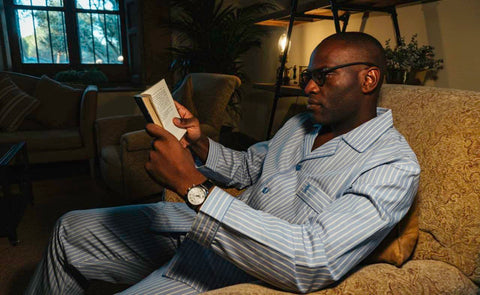There has been a lot written about what sleep and rest look like at any age. Sleep in young adulthood, up to the beginning of middle age, is important, as is the choice of the best pajamas that fit the need of the moment. On this occasion, we will talk about how rest and sleep are influenced by pajamas during middle age.
At every stage of life, one must face different challenges to sleep. But often, sleep begins to become increasingly complicated during middle age or the 40s. Changes in hormones that influence sleep and circadian rhythms, a higher risk of health conditions that interfere with sleep, and the presence of chronic stress are some of the most common reasons why sleep tends to become more challenging as one ages.
If young adulthood has arrived at the door of many readers of this article, attention must be paid to sleep and time and attention must be invested in cultivating sleep and rest habits that are necessary and healthy. Middle age is when that free ride of disorder generally ends. To sleep well and take advantage of the benefits and protection of high-quality rest, we must pay attention to sleep every day; special attention should be paid to the use of appropriate pajamas and be cautious with their use. It is helpful and important to know what to expect from sleep during these years and why it must be cared for and cultivated so much.
How is Dreaming in the Mid-40s
For many, if not all, it may sound familiar, having slept like a log at 20 and quite well at 30, maybe even at 40. Then, at some point in your 40s or 50s, that sleep began to become unstable. Generally, you go to bed exhausted, but still have trouble falling asleep.
It is normal to wake up at least once or twice a night, sometimes to go to the bathroom, sometimes just because. Often, one does not sleep until dawn, wakes up long before the alarm goes off, and wishes they could take advantage of those extra 45 minutes or hours of rest. Well, that is the welcome to sleeping in middle age.
These years are some of the most difficult for sleep, for many who find themselves in this age range. Given everything that is happening during this stage of life, it is not surprising that sleeping is particularly complicated. Many during these years are in the agony of raising children and doing their best to give their all to work at the same time. They often find themselves helping to care for aging parents while figuring out how to pay for their children's college and finance their own retirement. These are just a few of the reasons why chronic stress and worry are major sleep issues during middle age.
At the same time, many biological changes are occurring that also make sleeping more challenging. For both men and women, the hormones that promote healthy sleep are decreasing. At the same time, the hormones that disrupt sleep, including cortisol and others, often increase due to stress and ongoing sleep deprivation.
Men face their own hormonal changes in middle age, including a natural decline in testosterone, which can adversely affect sleep quality. In turn, short sleep suppresses testosterone production, contributing to more sleep-related health issues, including obstructive sleep apnea and sexual dysfunction.
The architecture of sleep continues to change, and it also spends less time in deep sleep (and to a more subtle degree, less time in REM sleep). During these years, more sleep time is spent in the lighter and less restorative stages of non-REM sleep.
During these years, it is evident that insomnia particularly affects weight gain and metabolic health, both in men and women. The combination of ongoing biological changes and stressful, crowded daily schedules is not conducive to sleeping or exercising regularly, which can make a real difference for sleep and weight at any age, and especially during these years.
It's important to pay attention: Support good habits and daily choices that promote sleep and avoid those that harm it. A healthy diet, the choice and use of a pajama that helps to fall asleep and maintain sleep and rest, regular exercise, and attention to stress management can make a difference in sleeping well during some of the busiest and most challenging years of our lives.
Focusing on the fundamentals of sleep hygiene is an important topic that should always be taken into account. Continuing to sleep well is completely possible as one enters middle adulthood, but it generally does not happen by accident. Maintaining a high level of sleep requires some commitment and attention as one ages. Following a regular schedule for sleeping and waking up, getting sunlight in the morning, avoiding stimulants at inappropriate times, wearing clean pajamas suitable for one's personal situation and the current weather conditions, can help continue to achieve restorative sleep at 40 or older.
Ways to Improve Both Sleep and Mental Health
While sleep and mental health issues do not have a one-size-fits-all solution, discovering the right solution may work wonders for everyone.
Follow a Consistent Sleep Schedule
Consistency is key when it comes to resting each night. A consistent sleep schedule is one of the most important sleep habits you can create, along with the use of pajamas. Not only does going to bed at the same time every night and waking up at the same time every morning help you sleep better, but it can also work wonders for your mood and overall health.
This consistency can elevate mood and help protect against depression and anxiety, as well as against health issues such as high blood pressure, high blood sugar, and high cholesterol.
A good way to help sleep on a consistent schedule is to sleep according to a chronotype. The chronotype is related to the body's circadian rhythm, which controls the sleep-wake cycle. The chronotype is the body's natural inclination to be awake or asleep at certain times and varies from person to person. That is why it is so important to take care of rest; to respect daytime nap hours, and the use of appropriate pajamas.
With all that, we suggest you visit our website El Búho Nocturno where you can find the pajamas that best suit your preferences and tastes.

